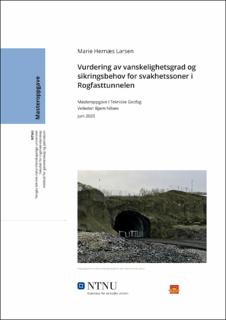| dc.contributor.advisor | Nilsen, Bjørn | |
| dc.contributor.author | Larsen, Marie Hernæs | |
| dc.date.accessioned | 2021-09-24T17:44:52Z | |
| dc.date.available | 2021-09-24T17:44:52Z | |
| dc.date.issued | 2020 | |
| dc.identifier | no.ntnu:inspera:54979149:31144537 | |
| dc.identifier.uri | https://hdl.handle.net/11250/2781570 | |
| dc.description.abstract | Masteroppgaven vurderer vanskelighetsgrad og sikringsbehov til åtte utvalgte svakhetssoner i Rogfasttunnelen.
For å vurdere vanskelighetsgraden til svakhetssonene er det utarbeidet et poengsystem som tar hensyn til sonenes seismiske hastighet, bergoverdekning, krysningslengde, vanntrykk og tilstedeværelse av svelleleire, grafitt og løsmasser. Poengsystemet er anvendt på de åtte utvalgte svakhetssonene på Rogfast og på problemsoner påtruffet i Bjorøy-, Oslofjord- og Atlanterhavstunnelen. Ved å sammenligne total poengsum til svakhetssonene på Rogfast med total poengsum til svakhetssonene i Bjorøy-, Oslofjord- og Atlanterhavstunnelen er det funnet ut at fem av de utvalgte svakhetssonene på Rogfast plasseres i samme poeng-område som de ferdigstilte tunnelene. Basert på dette er det konkludert med at det er en risiko for å møte like vanskelige svakhetssoner i Rogfast som det ble gjort i Bjorøy-, Oslofjord- og Atlanterhavstunnelen.
En fordel med poengsystemet er at det tar hensyn til flere faktorer enn tidligere benyttede klas- sifiseringssystem. I tillegg gir poengsystemet en skjematisk fremstilling av hvilke forhold som forventes å bli vanskelige og gjør det dermed mulig å optimalisere sikringsmengden. Ulempen er at faktorene ikke er vektet ut ifra innvirkning på vanskelighetsgrad, i tillegg til at flere viktige faktorer, som bergspenninger og innlekkasjeforhold, er utelatt.
Det er funnet en sammenheng mellom at en høy total poengsum samsvarer med en høy sikringsklasse. Videre er det funnet ut at samtlige vurderte svakhetssoner på Rogfast har et høyt sikringsbehov, da tre av dem er i sikringsklasse V og fem av dem er i sikringsklasse VI. Numerisk analyse utført på svakhetssone 31 indikerer at det vil være lave spenninger og høye deformasjoner (maksimal deformasjon på 66,0 cm) uten sikring. Med innsatt sikring, modellert som sprøytebetongbuer og bolter, har deformasjonen blitt redusert til 7,6 cm.
Aktuelle og relevante tiltak på Rogfast som kan bidra til å redusere risiko forbundet med vanskelige svakhetssoner er blant annet: nøye planlegging for driving gjennom svakhetssoner og prosedyre ved kritiske situasjoner, ingeniørgeologisk oppfølging på stuff og sonder- og kjerneboring i kombinasjon med seismikk på stuff. Dersom dette utføres, i kombinasjon med bergsikring, vil det være mulig å krysse svakhetssonene. Dette forsterkes av erfaringene fra driving av sidetunnelene på Mekjarvik og Arsvågen der forventede svakhetssoner ikke førte til nevneverdige problemer og driveforholdene generelt var bedre enn antatt. I tillegg har vanskelige svakhetssoner blitt krysset i norske undersjøiske tunneler tidligere, som f.eks. i Bjorøy-, Oslofjord- og Atlanterhavstunnelen. | |
| dc.description.abstract | This master’s thesis examines the degree of difficulty and rock support requirements for eight difficult weakness zones along the Rogfast tunnel.
A point system was developed to consider the degree of difficulty of the weakness zones. The point system took the seismic velocity, rock cover, crossing length, water pressure and the presence of swelling clay, graphite and soil into consideration. The point system was applied on the eight chosen weakness zones at Rogfast and on problem zones in the Bjorøy-, Oslofjord- and Atlantic Ocean tunnel. By comparing the total score of the weakness zones at Rogfast with the total score of the problem zones in the completed tunnels, it was discovered that five of the weakness zones at Rogfast had a total score in the same range as the completed tunnels. Based on this, it was concluded that there is a risk of encountering difficult zones at Rogfast, similar to those encountered in the Bjorøy-, Oslofjord- and Atlantic Ocean tunnel.
One advantage with the point system used is that it takes several factors into consideration that were not present in previous classification systems. In addition, the point system provides an overview of specific factors that are expected to be difficult and this offeres an oppurtunity to optimize the rock support. Disadvantages with the point system include the fact that the factors are not weighted based on impact on degree of difficulty and that the point system does not take all of the important factors into consideration.
The evaluated weakness zones demonstrated a connection between a high total score and a high rock support class. All the chosen weakness zones had a high rock support requirement. Three of the weakness zones were in rock support class V and five of them were in rock support class VI. Numerical analysis on weakness zone 31 indicated that there would be low stresses and high deformations (max. deformation of 66.0 cm) without rock support. With rock support, modelled as bolts and reinforced ribs of shotcrete, the deformation would be reduced to 7.6 cm.
Relevant measures at Rogfast that can contribute to reduce the risk associated with difficult weakness zones are among others: detailed planning for excavating through weakness zones, follow up from geologists at the tunnel face and probe- and core drilling in combination with tunnel seismic prediction. If these measures were to be implemented, in combination with rock support, it would be possible to excavate through the weakness zones. This assertion is supported by the experiences from the access tunnels at Arsvågen and Mekjarvik, where expected weakness zones did not lead to significant problems. In addition, several difficult weakness zones are crossed earlier in Norwegian subsea tunnels, e.g. in the Bjorøy-, Oslofjord- and Atlantic Ocean tunnel. | |
| dc.language | nob | |
| dc.publisher | NTNU | |
| dc.title | Vurdering av vanskelighetsgrad og sikringsbehov for svakhetssoner i Rogfasttunnelen | |
| dc.type | Master thesis | |
